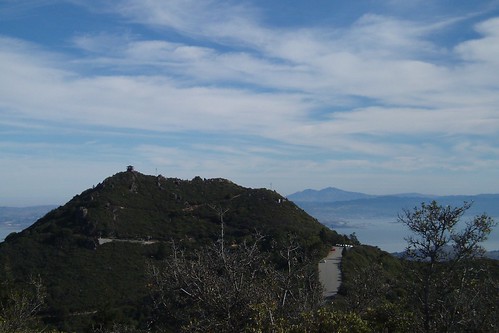
Tamalpais (East Peak) and Diablo, from the Middle Peak of Tamalpais
Chronicle architecture critic John King, on my favorite Bay Area landmark:
Regions are all but impossible to define - even ones that, like the Bay Area, seem obvious on a map.I first fell in love with Diablo 30 years ago, on a family outing not long after moving out here from New Jersey. Diablo seemed quintessentially Western--rugged, rocky, and dry--and I imagined filming a shootout among the outcroppings. To a kid fresh from exile in in the East, this was Home.
The orderly lines disappear in real life...The only way to keep your bearings is to grab hold of an anchor.
That means a landmark like Mount Diablo, the Contra Costa peak that is the vertical equivalent to the body of water that gives our region its name. You encounter it in places you'd never expect, and even though it never looks the same from any angle, you always know what it is. And where you are....
Sure, there are plenty of other Bay Area bumps....But Mount Diablo is different, rising from a long ripple of ridges with enough oomph that it's a thing unto itself rather than a culmination of hill upon hill. It also packs a one-two punch, a mountain that's a pair of peaks, one sharp and one soft.
There's also the way it rises with grand nonchalance from the suburbs nestled on the north and east. In spring it's a beckoning green, while in late summer the slopes resemble burlap, weathered but certain to endure....
The mountain's visual power also is heightened by the fact that so much of the terrain around it is undeveloped - a tribute to open space advocates and the group Save Mount Diablo, which was founded in 1971 and has helped Mount Diablo State Park grow from 6,788 to nearly 20,000 acres.
The wonder of the mountain, though, is the spell it casts from afar. It registers as a centerpiece, an orientation point that signals the connection between otherwise disparate parts of the region.
For instance, the sound-walled sprawl of eastern Contra Costa feels like it could be anywhere - except that to the west is Mount Diablo at its most abrupt, kicking into the sky from the orchards that remain. On the west side of the bay, meanwhile, the top of Mount Diablo is on view from vantage points above the shoreline of San Francisco's Bayview district. The mountain links these two realms that otherwise are worlds apart.
That's another thing I like about Mount Diablo: You encounter it constantly, without effort. Sometimes it spreads out like a glorious feast, especially when you're heading east from Orinda on BART or Highway 24, a gentle giant surrounded by a crowd of hillocks. Looking north from the Tri-Valley area, by contrast, it doesn't seem so much tall as broad. And if you're driving back into the region from the Central Valley, it's a distant glimpse that signals journey's end....
Plenty has changed for "Monte" since [1860]. There are roads, campgrounds, radio antennas and an aviation beacon that comes alive each Dec. 7. The landscape that unfurls below includes office towers, shopping malls and cities with more than 100,000 people....
But the next time you stand along the inner shoreline or move beneath Mount Diablo, consider: The essence of this place remains. It binds us. And we all have a stake in its future.
I still get a little thrill every time I see Diablo--and you can see it from all over. From Tamalpais, of course (35 miles). On a clear day I can catch a glimpse of it from the bus as we top the hill at Turk and Roselyn (30 miles). Coming home from Sacramento, Diablo is there most of the way. Working in Modesto for six weeks, I took comfort in being able to see a landmark that was also visible from near my home (53 miles).
Closer in, you notice two things. The first is that it's really, really big. Not huge like Rainier or Shasta, but huge by any human standard. It's a massive presence.
The second is how far the burbs have advanced since I first visited. King is right about the success of efforts to preserve the mountain...but they haven't all been victories, and the tract homes now march right up to the park boundary in some places. We've lost a lot over the years.
Still, enough was saved to be well worth celebrating--30,000 or so acres on the mountain, and another 50,000 or so in the outlying foothills. That parkland is a testament to the people who saw the value of this amazing landmark, and understood the necessity of preserving it.
|